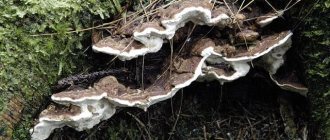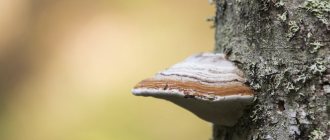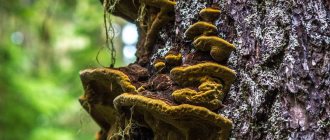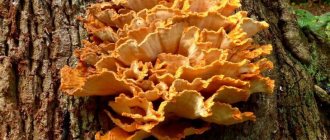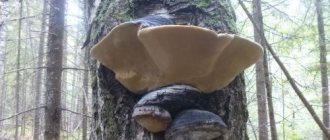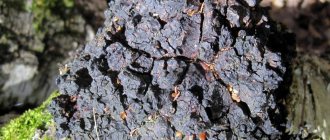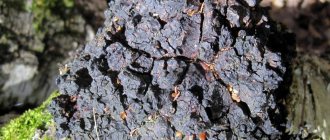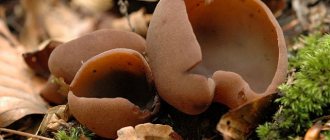Polypore fungi are parasitic organisms and almost all are enemies of trees.
They destroy their wood and can cause death.
The mycelium (the vegetative body of the fungus) carries out vital activity in wood, both dead and living trunks, stumps, roots, and sometimes in branches.
Polypores have thin, colorless, sometimes brown hyphae, 2-5 microns in diameter. Polypore fungi spread in the substrate and feed on the vegetative substrate. Living mycelium contains about 90% water, which is lost during drying. The fruiting bodies are an order of magnitude less watery, but they still contain a lot of water.
Use in traditional medicine
In many Asian countries, the hedgehog has been used for many centuries not only as a food product, but also as a medicine.
Over the past 10 years, this medicinal mushroom has become more popular due to its therapeutic abilities in the fight against neurodegenerative diseases. In the East, mushrooms are traditionally revered and called “spiritual plants.” They are believed to bestow longevity and spiritual strength. A study published in the Journal of Restorative Medicine states that Chinese and Japanese medicinal practices have traditionally used the urchin to normalize intestinal function, strengthen the spleen, and as an anti-cancer agent. In traditional medicine, this mushroom is considered very beneficial for five internal organs: lungs, heart, spleen, kidneys and liver. It is also able to improve digestion, give strength and vigor.
Crested hedgehog
Lion's mane is used in Traditional Chinese Medicine to relieve symptoms of Qi deficiency (lack of "vital energy"), and is also used for problems with the central nervous system, insomnia and weakness.
Contraindications to the use of tinder fungi
It is not recommended to use mushrooms and medicines based on them in the following cases:
- during pregnancy and during breastfeeding;
- when individual intolerance is detected;
- in the presence of urolithiasis;
- with hemorrhagic diathesis;
- if you have problems with blood clotting;
- with anemia;
- with uterine bleeding;
- Mushrooms should also not be given to children under 7 years of age.
An overdose of tinder fungi and drugs prepared with their use makes itself felt with symptoms such as: loss of coordination, nausea, vomiting, the appearance of redness and rashes on the skin.
Experts also do not recommend combining tinder fungi with medications - antibiotics, anticoagulants, amphetamines, painkillers, as well as drugs whose action is aimed at lowering blood sugar levels.
Fruiting body of tinder fungus
The fruiting bodies of tinder fungi, unlike cap mushrooms, are long-lived.
Their anatomical structure is quite simple - they consist entirely of hyphae, of which there are three main types: generative, skeletal and connecting.
According to their shape, the fruiting bodies of tinder fungi can be divided into the following main categories: prostrate, sessile and differentiated into a cap and a stalk.
But there are various transitions between them, and within the boundaries of the first family and even genus, fruiting bodies of various shapes can be observed.
Differences in the fruiting bodies of the tinder fungus
The prostrate fruiting bodies of polypores have the appearance of a film or plate, more or less adherent to the substrate and repeating the features of its surface.
The edge of such a fruiting body can be tightly adherent and disappearing, or raised in the form of a thick ridge. From time to time, its fusion with the substrate is loose, and when it dries, the edge bends and curls up.
Sessile fruiting bodies have a hoof- or cantilever-shaped, sometimes tongue-like shape, and are attached by a wide base or side. In some polypores, the narrowed base of the fruit-bearing bodies attached laterally stretches into a lateral stalk.
For example, the Schweinitz polypore (Phaeolus Schweinitzii) forms forms with a rudimentary and even noticeable stalk at the base of trunks and on the roots of trees, while on a vertical substrate it is capable of creating sessile fruiting bodies.
Dimensions of tinder fruiting bodies
As for size, some polypores from the genus Tyromyces have fruiting bodies only 0.5-1 cm in diameter, and, for example, in the true polypore (Fomes fomentarius) and the flat polypore (Ganoderma applanatum) they can reach up to diameter up to 1 m and weight up to 10 kg.
Prostrate fruiting bodies from time to time stretch along the substrate (dead trunk or log) by 1-1.5 m.
But these are the last limits, and usually the diameter of the fruiting bodies of tinder fungi is 5-25 cm. Their sizes also depend on the weather and the position and condition of the substrate.
Tissue density and surface layer of polypore fruiting bodies
The fruiting bodies of polypores can be filmy, waxy, fleshy, leathery, corky, woody, spongy or fibrous mixture, with all the transitions between these categories.
In some cases, they have a two-layer fabric, with the upper layer of the cap usually consisting of loose, spongy tissue, and the lower one, adjacent to the hymenophore tubes, of denser and smaller-sized tissue.
The surface of the fruiting bodies may be covered with a dense, sometimes shiny or matte crust, or a narrow, parchment-like skin, or completely devoid of cuticle.
But such a “bare” surface can be wrinkled, concentrically furrowed (which is associated with the uneven growth of the fruiting body), velvety, felt, hairy or coarsely bristly.
With age, the cover of the cap may change.
Coloring of polypore fruiting bodies
The colors of the fruiting bodies of tinder fungi are very diverse, and the color of the tissue, noticeable in the cross section, often differs from the colors of the upper and lower surfaces.
Some tinder fungi are characterized by a striking cinnabar-red, orange, or yellowish color of the tissue, but in most cases it is snow-white, yellow, cream, or pinkish. The color of the surface can be light (snow-white, gray, pale cream, wood yellow), black (brown, dark) or various bright colors.
Often the surface of the fruiting body is painted with concentric alternating dark and light zones, and different colors of brown, coffee, grayish, yellowish, and orange can be observed.
When dried, the colorful colors often fade, turn white, the fruit body becomes dirty, covered with vague brown or yellowish spots, or even completely darkens.
How to prevent tree tinder infestation
Under normal conditions, tinder fungi take a very active part in the process of decomposition of dead wood. However, if tree fungi spread to healthy plant crops, they become very dangerous for forests and gardens.
If fruiting bodies of polypores are found on branches, it is necessary to carry out sanitary pruning in order to prevent the spread of infection. All cut branches are burned, and healthy wood is treated with a special garden varnish or covered with oil paint. The trunk of the tree must be treated annually with lime solutions. It is also very important to maintain plant immunity at a high level, following the recommendations for cultivation and care.
Inedible tinder fungi
Inedible polypores are not deadly, but can cause unpleasant symptoms:
- allergic reaction;
- intoxication of the body with corresponding symptoms - vomiting, dizziness, nausea.
Many tinder fungi, including inedible ones, are actively used in medicine - medicinal products are prepared from them. Any use of mushrooms should be preceded by consultation with a physician.
Birch
Likes to grow on dead birch trunks. Its body is convex, gray-white in color. It contains many amino acids and microelements. This was appreciated by microorganisms and insects, who generously laid larvae in the mushroom. Pharmacology uses mushroom polymers isolated from this mushroom to produce dietary supplements for diabetics.
The video talks about birch polypore, its various uses (medicine) and other beneficial properties. The blogger shows from his own experience how to use it correctly:
Beveled
It is also called chaga. Grows on birch, alder, and rowan trees. The body is hard, woody. The shape is irregular, the surface is rough. Color – dark brown or black. There are white veins on the cut. Chaga is used in medicine - for decoctions and infusions.
Coarse-haired
Prefers stumps and semi-dry trees. The hat is large and rough, looking like a sponge. At a young age it has a yellowish or grayish color, and as it grows it becomes brown with a greenish tint. The taste of the pulp is unpleasant - bitter, reeks of anise.
Humpback
The hat has the shape of a semicircle. The shade is greenish. The pulp is dense - white or yellow. The surface of the cap is velvety. The mushroom strengthens blood vessels. It is part of drugs used to treat sarcoma, throat cancer, and leukemia. Recent studies have shown that the humpback polypore has a detrimental effect on the AIDS virus.
Larch (real)
Grows on larches, fir, cedar. Has a thick fruiting body. Length – 30 cm. Color – white or yellow. The surface is rough. There are furrows and brown spots. Young - soft, later - hard, crumbling. The taste is bitter.
Lacquered (reishi)
A mushroom with unique properties. It is actively used for the treatment of oncology and the cardiovascular system. Demanded in folk medicine.
What preventive measures are considered effective?
Preventing a problem from occurring is much easier than solving the problem later. Especially in the case of parasitic fungi, which occupy trees completely unnoticed, leaving them with a negligible chance of recovery. Therefore, let's think logically: mushrooms choose those plants that are damaged and have a weak immune system. This means that in order for the tree not to fall into the risk zone, it is necessary to achieve its absolute health. How to do it? Nothing complicated:
- timely and regularly feed the inhabitants of the orchard;
- be sure to carry out seasonal pruning, do not allow the crown to thicken;
- Carefully remove diseased or damaged bark, treating the “wound” with garden varnish;
- take care of the trees, do not let their development take its course.
If you notice that the bark on the tree is peeling, be sure to remove it with a wooden stick, and then treat the trunk with lime in winter.
As a preventive measure, experienced gardeners recommend using iron sulfate, a 5% solution of which should be sprayed annually on garden trees after the end of the deciduous period - that is, when there are no longer leaves on the branches.
If you suddenly find that a branch has broken on a tree or some kind of mechanical damage has appeared, be sure to prepare a solution of copper sulfate or the same garden varnish. These are the main medicines that not only can, but also need to be used to treat the wood of fruit trees. Remember that any crack or cut can become a wide open gate into which trouble in the form of tinder fungus can enter completely unnoticed.
Join our Facebook group
Edible tinder fungi
Liver polypore
Last year in the foothills of the Caucasus was dry and not mushroom-free. Regularly during the summer I collected, for the most part, only liverwort, or liver polypore (Fistulina hepatica). Our forest is oak-hornbeam, liverwort grows on oaks, settling in places where bark or wood is damaged.
The mushrooms are bright, noticeable from afar, with a red-brown upper surface, velvety in youth, shiny in adulthood and an amazing pattern on the cut. Mushrooms have a lateral stalk that grows from the bark, and the lower spore-bearing layer is tubular.
This amazing mushroom accumulates vitamin C, which is why it has a sour taste. When fried, the sourness is quite noticeable, it’s not for everybody, but when marinated, the mushroom is great!
It is impossible to confuse liverwort with other mushrooms; it is edible in young and middle age.
Liverwort, or liver polypore (Fistulina hepatica). Tatiana Nikolina
Liverwort in section. Tatiana Nikolina
Sulfur-yellow tinder fungus
From the beginning of spring (in our country from April, in the middle zone - from mid-May) the sulfur-yellow tinder fungus (Laetiporus sulphureus) begins to sprout on the stumps of deciduous trees and on the trees themselves, if they are unhealthy. It is so brightly colored that it is impossible to pass by. Young fruiting bodies look like foam on the tree trunk.
And only with age does the mushroom acquire a certain meaningful shape, very pretty, as well as a brighter color with orange tones. Its surface is covered with yellowish fluff.
This mushroom tastes best in the form of “spray foam”, but with orange tints. It can be fried, boiled, pickled.
Mushrooms growing on coniferous trees can cause mild poisoning! You can only collect from deciduous trees.
Among other things, the mushroom is very “photogenic”; showing its images to friends and relatives is simply pleasant.
Beauty is beauty, and the damage to trees from the hen is an order of magnitude greater than from the liverwort: it modestly destroys the wood from the edge without causing significant damage, while the hen primarily affects the core of the trunk and is capable of bringing the tree to complete death. The hen does not rest on this and successfully continues to bear fruit on stumps, dead wood and rotten trunks. It affects fruit trees, most often cherries. So, if you notice it in the surrounding area, you should definitely collect it and consume it before the mushroom eats the entire garden.
It can be consumed not only “gastronomically”: the smoke from burning the fruiting body successfully repels annoying insects, and this mushroom also has medicinal properties.
In Chinese medicine, mushroom preparations are used to treat blood diseases and endocrine diseases; in oncology, they are used as an adjuvant.
Sulfur-yellow tinder fungus (Laetiporus sulphureus). Oleg Savelyev
Young sulfur-yellow tinder fungus. Jørgen Schyberg
Scaly polypores
At about the same time as chickens, scaly polypores (Cerioporus squamosus) grow. They are also very photogenic, especially considering the size (up to 40 cm) and the presence of brownish scales on the cap.
The bottom surface is coarsely porous. It is edible at a young age, when the edge of the cap elastically breaks off, and has a pleasant mushroom smell. Scaly polypores destroy wood, so collecting them is encouraged.
Polypores have predominantly lateral legs - this makes it more convenient for them to sit on a tree. But scales are found both with central and with legs offset from the center - when they grow on stumps or lying trunks.
Appearance of the mushroom
The tinder fungus reaches 1.6 m in diameter and weighs 5-6 kg. The fruiting body of the tinder fungus, as it ages, is transformed into a keratinized formation, the structure of which resembles tree bark. Externally, the fungal body resembles hoof-like appendages.
The tinder fungus more often settles on deciduous trees, less often parasitizes conifers: the resin found in the resin ducts of wood of representatives of the group Gymnosperms (conifers) has a destructive effect on the formation of the mycelium.
The types of tinder fungi are similar in shape. The fruiting body is saucer-shaped, bent downwards, but can also be leveled. The color palette is varied, ranging from gray to cinnabar red. It settles solitarily, but there are species that parasitize entire groups. The spores quickly spread to nearby trees.
Description of the tinder fungus:
- hymenophore tubular;
- the mycelium of the fungus affects the bark and cambium of the tree, less often the root system;
- lifestyle – parasitic;
- the tinder fungus has white flesh;
- spore reproduction.
Representatives of tinder fungi have a leg, it is usually dense. The height of the stem is 4-12 cm. The mycelium of the fungus penetrates the cellular layers of the bark, cambium and roots of trees. The interaction of spores with the inner layers of bark harms plants. Very rare species are able to settle on the soil.
Medicinal properties of true polypores.
Popularly, the true tinder fungus is called the deciduous tinder fungus, the larch sponge and the blood sponge; the latter name is no coincidence, because it is used as a hemostatic agent. The pores of the true polypore perfectly absorb blood, creating something like a bandage.
The medicinal properties of real polypores are extensive. These mushrooms have been used for therapeutic purposes since Tsarist times. They became so popular in Russia that at some point they began to be imported abroad. The tinder fungus even received the honorary name “king of all medicinal drugs.”
These mushrooms were actively used for medicinal purposes in Greece. The Greek connoisseur Dioscorides called this mushroom a panacea and prescribed it for various internal diseases. The doctor believed that real tinder fungi help restore strength and relieve depression and fatigue.
Real tinder fungi were very expensive in Ancient Greece. King Mithridates found out that if you regularly take an infusion of this mushroom, you can protect yourself from the effects of poison. Throughout his reign, the king drank this remedy. And at one point the king became depressed, he wanted to poison himself by taking a large portion of poison, but the toxins not only had no effect, but did not even cause digestive irritation.
Real tinder fungi are capable of removing toxins from the body, this has been recorded by modern scientists. Tests were carried out on mice, and the results were amazing - arsenic compounds and mercury dichloride came out of the animals' bodies. This is facilitated by agaric acid contained in the fruiting bodies.
Also, real polypores are capable of restoring the liver. Mushrooms contain the polysaccharide lanophil, which stimulates the liver to secrete enzymes necessary for proper functioning.
The tinder fungus is a truly unique mushroom; it can also be used to treat the lungs. Infusions made from real polypores help with both common coughs and serious lung diseases, such as lung cancer and pneumonia. Polypore also gives good results against tuberculosis.
In China, drugs based on polypores have a very wide spectrum of action. They are used for excess weight, pulmonary diseases, diarrhea, liver problems and even impotence. In addition, real tinder fungi can help rejuvenate the body; they have a positive effect on the condition of the skin and relieve fatigue. Women claim that after taking drugs based on tinder fungi, the skin becomes tightened, and the nails stop peeling and grow faster.
Rules for collecting and storing true tinder fungi.
These mushrooms can be collected independently for medicinal purposes throughout the year. But they should only be cut from living trees.
For prevention purposes, tinder fungi are used for about a month twice a year. But in the process of treating certain diseases, the period increases to 4 months.
Infusions of tinder fungus are made using boiling water, warm water or vodka. The infusion must be insisted. And it should be stored in the refrigerator.
Doubles of real tinder fungi.
A similar species is the bordered tinder fungus. This is also an inedible mushroom. Its fruiting bodies are perennial, sessile, round or hoof-shaped. The diameter of the fruiting body can reach up to 30 centimeters, and its height is 10 centimeters. Concentric zones are clearly visible on the cap. The color of the cap is gray-gray, gray-brown or almost black. There is a yellow-orange edge. The pulp is elastic, dense, woody. The color of the pulp is beige or light brown.
These are saprophytic fungi and cause brown rot on trees. They grow everywhere in the temperate zone. Ringed polypores settle on dead wood of coniferous and deciduous trees, but can infect living weakened trees. In Siberia, these fungi cause damage; they cause wood to rot in logging sites and warehouses.
Preparations for homeopathy are made from tinder fungus; they are actively used in Chinese folk medicine.
Where does the tinder fungus grow?
Polypores grow in any part of planet Earth where there are trees. They settle on different parts of living and felled trees, processed wood - timber, and wooden buildings.
They can be found in forests, gardens, parks, suburban areas and cities. Few tinder fungi live on living trees: most representatives of the genus prefer dead wood. The habitat of polypore fungi covers temperate and tropical regions, but there are also varieties that live in more severe climatic conditions.
Reishi mushroom against cancer
Reishi (lacquered tinder fungus) is one of the most popular medicinal mushrooms on the planet, used in medical practice for more than 4 millennia (especially in the East). In ancient times, the culture was available only to members of the imperial family, since the cost of a gram of fruiting bodies was equal to 1 gram of gold.
In 1980, a group of scientists from Japan's Shizuoka University and the National Cancer Center isolated the powerful antitumor element beta-glucan from polypore. Its main pharmacological effect is to stimulate specific cellular immunity and increase the body's defenses. When the substance is introduced into the blood, the polysaccharide binds to the surface of cells responsible for anticancer protection. As a result, natural killer cells, macrophages and cytotoxic T-lymphocytes are activated.
It is interesting that in the body of a healthy person there is a continuous destruction of atypical structures. In this case, macrophages quickly recognize and eliminate altered cells. Along with this, T-lymphocytes come close to the malignant elements, releasing polymer proteins (perforins, granzymes) onto its surface. This substance is embedded in the membrane of the cancer cell, making a “perforin hole”, as a result of which it dies. If the first protective factors do not work, natural killers enter the fray. However, with constant stress, consumption of junk food, and excessive physical activity, a decrease in their functional activity is observed. Due to this, the risk of tumor processes increases 3 times. In addition, in cancer patients, cells are in a depressed state and are often represented by young immature forms (not capable of active action).
Antitumor effects of beta-glucans concentrated in the bodies of polypores:
- Macrophages are activated, which leads to an increase in their absorption capacity.
- They accelerate the maturation of lymphocytes, resulting in the formation of many mature, combat-ready killer cells.
- They enhance the cytolytic activity of protective proteins (perforins and granzymes).
- Increase the life cycle of natural killer cells, macrophages and T-lymphocytes.
- Stimulates the synthesis of Tumor Necrosis Factor (interleukins and TNF-alpha).
In addition to glucans, reishi fruiting bodies contain substances that block the development of the circulatory system of cancer (sodium pyroglutamate and ergosterol). As is known, a tumor releases a substance into the blood (vascular growth factor), under the influence of which the body triggers the “building” of new capillaries for the tumor (to obtain nutrients). When reishi mushroom is consumed, the synthesis of vascular growth factor is sharply inhibited, as a result of which the neoplasm and its metastases gradually “dry out.”
Impact of tinder fungi on the cardiovascular system
The positive effect on the condition of the heart muscle is due to the presence of organic germanium in the tinder fungus. It improves blood circulation, as a result of which the risk of oxygen starvation of tissues is significantly reduced.
The benefits of varnished tinder fungus for the heart and blood vessels are as follows:
- decreased platelet aggregation in the blood, which reduces the risk of heart attack or stroke;
- expansion of the coronary arteries that support the myocardium during the period of oxygen starvation;
- providing a cardiotonic effect that reduces the negative effects of prolonged heart failure;
- reducing heart rate and load on the myocardium, increasing valve elasticity.
Read: Fertilizer and mulch from marigolds - Benefits in the garden
Use in folk medicine
The tinder fungus forms the basis of many homemade medicines. This is explained not only by its medicinal properties, but also by its availability. Recipes using birch mushroom are easy to follow and very effective.
Tincture
Preparing a tincture from alcohol and tinder fungus is a fairly easy process. You need to cut out the spongy core from it and grind the solid part into powder, after which the ingredients are mixed in the following proportions:
- 5 g crushed piptoporus;
- 150 ml vodka.
Send the tincture to a dark, cool place for two weeks and take 1 tbsp. l. 3 times a day, if we are talking about neoplasms. For the treatment of diseases not associated with tumors, the dose of tincture is reduced to 1 teaspoon, which is recommended to be drunk before breakfast, lunch and dinner. The course of taking the medication is approximately 3 months. The speed of recovery depends on the type of disease and its severity.
Infusion
For food poisoning and the treatment of stomach ulcers, an infusion of birch mushroom is very useful.
It is worth noting that the preparation will take several hours and will take place in stages:
- Rinse the mushroom thoroughly and place it in a container with warm boiled water for 5 hours.
- Then pass through a meat grinder, and set the water in which the mushroom was infused aside (it will be useful in the future).
- Mix a glass of crushed piptoporus with 5 glasses of mushroom water heated to 50˚C and leave for two days in a cool, dark place.
- Drain the liquid and squeeze out the pulp thoroughly using gauze. As a result, thick juice is released, which must be diluted with boiled water.
Powder
Birch mushroom powder is good for wounds and other skin damage. Before applying it, the injured area must be treated with hydrogen peroxide and only then applied with a bandage.
Weightloss remedy
Polypore is often used as a means of losing weight. To do this you need to take:
- 1.5 kg of finely chopped mushroom;
- 500 g rose hips,
- 100 ml black tea;
- 1 liter of boiling water.
Mix these ingredients and leave for 4 hours. Heat the resulting infusion well, pour it into a thermos, add another 0.5 liters of cow's milk, and then stir. Drink 150 ml of the finished product 30 minutes before meals. If the drink seems too bitter, it can be sweetened with 1 tsp. natural honey.
Tinder powder diluted in a glass of water will be no less effective in the fight against excess weight. The liquid should be drunk immediately after adding it. For faster results, it is recommended to drink two glasses of mushroom water a day 30 minutes before meals.
Another easy recipe looks like this:
- 0.5 tsp. mix crushed piptoporus with 200 ml of boiling water;
- heat in a water bath for 15 minutes.
Drink the finished product one sip at a time throughout the day.
Polypore not only reduces appetite, but also weakens cravings for certain foods. However, this does not mean that it is a panacea for excess weight. It is recommended to combine any diet with sports and a range of health treatments.
Recipes and cooking features
Very few types of tinder fungus can be eaten with great caution. After careful heat treatment, all parts of the scaly, leafy, sulfur-yellow and cap of the winter tinder are edible. Before cooking, all collected mushrooms must undergo heat treatment in the form of boiling for 40-50 minutes.
The most popular recipe is the preparation of tinder fungus with onions. To do this, the fruiting bodies are peeled and soaked in water for several hours; after boiling, they are finely chopped and fried. At the end of frying, add onion and simmer for 10-15 minutes. The finished dish is sprinkled with herbs.
Pickled tinder fungus
To prepare tinder fungus with sour cream, you need to prepare onions, sour cream, vegetable oil, dill and pepper. Boiled mushrooms are chopped and fried with onions, after which sour cream is added. The finished dish is sprinkled with dill.
Consumption of even young tinder fungus can cause poisoning, so it should be dosed - a small portion of several spoons no more than once a week. Not recommended for use by children and pregnant women.
Maitake
Meitake mushroom is also called "ram mushroom" or "dancing mushroom". This mushroom is incredibly valued in Eastern medicine. The medicinal properties of Meitake are currently being actively studied all over the world, but the mushroom itself has been used in medicine for many centuries. The healing properties of this mushroom are rightfully considered one of the most powerful.
The main medicinal power of the mushroom comes from the beta-glucan polysaccharides it contains. Studies have shown that they have pronounced antiviral and antitumor properties. Medicines from Meitake have a very good anti-cancer effect. In 1994, studies were conducted in US hospitals that confirmed its high effectiveness in cancer patients. The mushroom has also proven itself in getting rid of benign neoplasms, such as fibroids, fibroids, cysts and mastopathy.
Meitake is also called “female mushroom” because it is very popular with women. Gynecologists note the remarkable property of Meitake to improve the well-being of women during the premenstrual and menstrual cycles. The mushroom can reduce pain and improve well-being. Taking Meitake normalizes hormonal levels in women. In addition, taking Meitake normalizes hormonal levels in menopausal women, reduces sweating and hot flashes.
The Meitake mushroom has another name. In ancient Japan it was called “geisha mushroom” because. Even then, its ability to reduce weight was noticed. In our time, studies were carried out in Tokyo, during which this was completely confirmed. The substances that make up the mushroom break down fat cells very well, then remove them from the body with water.
Classification of parasitic fungi
An entire dissertation could be written about the variety of forms and types of parasitic fungi. In short, depending on the specialization (the choice of the host on which or in which the spores settle), they are divided into two types:
- Obligate (having a narrow range of certain varieties of vegetation on which they parasitize, for example, smut fungi, which attack exclusively cereal crops).
- Facultative (they are also saprotrophs, which have no restrictions in specialization, for example, late blight, which parasitizes all types of nightshade crops).
Another classification of parasitic fungi is based on the method of reproduction and also divides them into two groups:
- Microparasites. Reproduction of fungi occurs directly in the host’s body or in cells, for example, in other types of fungi or in insects, such as Cordyceps, which lives in caterpillars.
- Macroparasites. Parent parasites feed on the host’s body, but the reproductive forms leave it and settle on new hosts, for example, ergot.
As for the choice of host, depending on the specific type of parasitic fungus, it can be plants, tree crops, other fungi, fish, insects, animals and even humans. In the latter case, they cause a number of dermatological, fungal and mycotic diseases that are unpleasant and even dangerous for the human body and require treatment, among them:
- allergy;
- otitis;
- bronchitis;
- pneumonia;
- ringworm;
- candidiasis and others.
We present to your attention a small selection of the most famous parasitic mushrooms with a brief description and photo.
Useful properties of tinder fungus
The idea of collecting tinder fungi for the purpose of subsequent consumption seems strange only for the first time. In fact, the name “tinder fungi” includes a huge variety of fungi, of which the woody hoof-like growths on trees are only a minority. In general, the very concept of “tinder fungi” is known to science only indirectly, as something meaningless and amateurish. According to science, tinder is a genus of woody perennial fungus, from which tinder was once made. Everything else is called something else.
In the popular concept, a “tinder fungus” is something that grows on a tree and does not look like an ordinary “cap” mushroom. There are also terrestrial polypores (in fact, rather special oyster mushrooms) - the genus Polyporus. They look like tubular ones (and their hymenophore is completely tubular), but the rubbery-inextricable flesh will not allow you to make a mistake. Among the polypore "tinder fungi" there are many edible ones. But first things first.
Cut tinder fungus.
The most popular tinder fungus among people is the sulfur-yellow tinder fungus. People (not ours) call it “witch’s oil,” and for good reason. At the end of May, take a walk through the deciduous forest, look for old oaks and lindens - you will probably see on one or two a lumpy, jelly-like mass of sulfur-yellow color, as if runaway dough. You can see it from afar on the dark trunks of the open oak forest! If found, congratulations; So we met the sulfur-yellow tinder fungus in its edible form. Now all you have to do is take out a knife, cut out the pulp (while it is still pulp), and go home - either to fry, or to salt, or to stuff into pies. A universal mushroom, very valuable in the relative “mushroom-free” conditions of early summer.
Another famous edible tinder fungus is the ram mushroom. (In fact, there are a number of celebrities of this level: Grifola umbelata, the famous “mushroom cabbage” Sparassis crispa.)
Grifola mushroom.
A very interesting, although quite rare, is the “tinder fungus” called the liverwort. In autumn, meat-red tongues of the fungus appear on damaged trunks of linden and oak trees; the physiological sensation intensifies when cut - more meat than mushroom. Drops of red juice that look like blood. It seems as if the tree has sinned deeply in some way and is now being punished by the forest gods. However, this does not stop people from collecting young liverworts and eating them. They write that it is healthy, with vitamins.
Finally, the most “culinary” and widespread genus of tinder fungi is Polyporus. As a rule, these are cap mushrooms with a tubular hymenophore; their edibility is inversely proportional to the degree of hardness of the fruiting body. For example, the “spider,” a scaly tinder fungus that appears in early summer, is relatively soft and therefore edible. Even softer and more edible is the small tuberous tinder fungus, characterized by wide pores. But the May tinder fungus is, in a sense, a transitional form between food and technical tinder fungi. When I get a little bit of it, I crumble it into the soup for flavor. It smells good.
Edible mushroom or not
Most representatives of the tinder family belong to the group of conditionally edible ones. However, two opinions are equally popular among mushroom pickers: some consider it inedible, others consider it quite suitable for food.
If we talk about birch mushroom, then its pulp contains no substances that can be dangerous to humans. If mushroom pickers refuse tinder fungi, it is usually only because the fruit’s taste is not the best. The pulp of old mushrooms becomes hard and tasteless. In addition, it develops a pronounced bitter taste.
Common types of tinder fungus
Currently, several dozen species of these fungi have been described. They are quite widespread, because in most cases they are unpretentious to living conditions - wherever a sufficient number of deciduous trees grow, the tinder fungus will inevitably settle. These mushrooms are found in Russia from the European part to Siberia and the Far East, throughout Europe and the USA. They prefer a temperate climate, so they are not widespread in tropical latitudes.
Below are several species that are most often found in our country. First comes the edible varieties.
Sulfur-yellow tinder fungus
This species has a beautiful bright yellow coloration. It always grows in groups and is found in our country only in the European part. Most of all he likes to settle on oaks, cherry trees, poplars, rowan trees and beeches. A characteristic feature is that the family of mushrooms resembles foam frozen on the bark of a tree.
You can take a whole nest of mushrooms at once, and they are too large; it is better not to use old representatives
And one more important rule for collecting - while sulfur-yellow tinder fungi from deciduous trees are absolutely safe, then it is better not to collect them from coniferous trees - there is a slight chance of mild poisoning
THIS IS INTERESTING
Sulfur-yellow tinder fungus
Common liverwort
The color of the cap resembles a liver, which is why the mushroom got its name. It also prefers the climate of the European territory of Russia, especially often settling under oak or chestnut trees.
Only young liverworts are eaten. It has a pleasant taste, with a slight sourness. Most often it is fried or stewed with onions and potatoes, like other mushrooms.
Scaly polypore (variegated)
This species has a soft and rather thick cap. Unlike many other tinder fungi, it even has a stalk, so it looks like an ordinary mushroom. It grows in the middle zone of our country. It is quite common in birch forests and grows even in the most unfavorable seasons due to its unpretentiousness.
However, mushroom pickers rarely take it because the pulp is quite hard. Most often it is consumed after prolonged cooking.
Scaly polypore (variegated)
Umbrella tinder fungus
It is rare in our country, but in neighboring China it is a very popular mushroom. It has small fruiting bodies, which, however, always grow in large families. It got its name from its umbrella-shaped hat.
Mainly prefers mild climates and oak, beech, and hornbeam forests. Along with the cap, it has a stem that resembles a rolled tube. In Chinese cuisine it is consumed both fried and boiled.
The following are inedible species of this mushroom.
False tinder fungus
Unlike the real thing, it is very tenaciously attached to the tree trunk. It has gray, beige and brown (sometimes rusty) shades of the fruiting body. This mushroom has no legs at all, and the cap is quite large - with age it reaches 25 cm in diameter.
Varnished tinder fungus
This mushroom has a very beautiful fruiting body, reminiscent in color of strongly brewed tea. Its surface is glossy and sparkles in the sun, which is how the species got its name. It is best known in China, Korea and Japan, where it is even nicknamed the “mushroom of immortality” because extracts of this species are used in local folk medicine.
Varnished tinder fungus
Why is the mushroom called tinder fungus?
The name comes from ancient times. Once upon a time, before the invention of matches, a flint consisting of flint, firewood and tinder was used to start a fire. Using a hammer and flint, a spark was struck, which was supposed to fall on tinder, a flammable material. Then the hard wood was ignited with flared tinder. A piece of fabric or cotton wool, dry moss, tree bark and wood-dwelling fungi of a loose, corky structure were used as tinder. Due to their ability to serve as tinder, these mushrooms were called tinder fungi.
A piece of tinder mushroom and flint
Chemical composition
Fruiting bodies are a source of useful substances. Hoof mushroom is rich in the following nutrients:
- polysaccharides;
- triterpenes;
- phytosterols;
- resins;
- essential oils;
- anthocyanins.
We recommend reading: Beneficial properties of Anzura (Suvorov) onion-garlic and contraindications
These valuable components help activate natural antitumor immunity and reduce the risk of developing coronary heart disease. The use of blood sponge-based products can improve the cognitive functions of the brain and eliminate diseases of the nervous system.
Optimal living conditions
Some species of polypores typically live only on deciduous trees, while others live only on coniferous trees. Light, humidity and temperature are of great importance for the growth and development of the fungus. Without light, the mycelium can grow calmly inside the tree, but the fruiting body cannot do without it. Humidity helps the growth of tinder fungi, which like to settle where there is dampness: in cellars, earthen shelters, wells and other rooms.
The tinder fungus feeds on wood. In order for the beneficial substances to fully saturate the mushroom, they must first be dissolved. Enzymes help in this process by converting insoluble compounds into soluble ones. When fungal enzymes act on wood, especially cellulose, rot (red and brown) is formed.
Wood contains a very small percentage of ash, so the parasitic fungus is not picky about the minerals it feeds on. If there are a lot of these substances, then the parasitic fungus grows faster, killing the host. The core of the tree is especially affected. If the temperature and pressure are not suitable for the parasitic fungus, then its growth stops. Gardeners take this into account when fighting infected trees.
The fungus can live both on a dead tree and on a living one, like a parasite, destroying it.
The consequence of the fungus feeding is the appearance of “sweetness” on the tree. In other words, the wood “suffocates”. This kind of rot is caused by the true tinder fungus.
Its wood feeding cycle can be divided into the following stages:
- browning of the ends of the log;
- “understeam” (appearance of white stripes);
- “marble rot” (the wood becomes completely soft).
Marble rot
Conclusion
The tinder fungus has hundreds of species, a variety of shapes and sizes. In relation to trees, these are parasitic fungi. But first of all, they are part of the cycle of substances in nature. Polypores decompose organic compounds in the soil to mineral ones. The symbiosis of fungi and plants has a positive effect on soil formation.
People have learned to use tinder in different ways:
- Firstly, it is a natural storehouse of medicinal substances widely used in medicine. They can heal various tumors, hepatitis B and C, fatty liver, asthma, tuberculosis. They have a hemostatic and laxative effect. The Japanese, when ordering this mushroom from us, use it as an excellent means for losing weight.
- Secondly, everyone knows that mushrooms are good meat substitutes. Therefore, they are gladly used for food. The most important thing in this case is the ability to distinguish an edible mushroom from an inedible one.
The tinder fungus is a real treasure given to us by nature.
Methods for growing tinder fungi at home
Polypore can be grown in a substrate, which is a mixture of sawdust, shavings, and the bark of small branches. It is poured with boiling water. After the substrate has cooled to room temperature, it is placed in plastic bags, first squeezed out and mixed with mycelium. Cuts are made in the bags and they are placed in a room with a humidity of 80%, natural light changes, and an air temperature of +20°C. After 30-40 days you can harvest the first harvest.
Stumps and wooden blocks can also be used as a substrate for growing mushrooms. Using a saw or drill, cuts are made into them, into which the mycelium is placed. The substrate must first be soaked in water. The bars with mycelium are placed in a shady place, sprinkled with leaves (for 100 g of mycelium you need 35 kg of substrate). If there is a drought, watering is recommended. The harvest can be harvested 4 months after planting.
Polypore can be grown by placing the substrate in plastic bags
